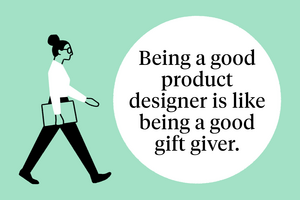Marketing Feb 1, 2025
Customers Will Pay More for Products That Feature Diversity in Ads
When an ad features people of different ages, races, genders, or nationalities, consumers believe the brand offers greater variety and is more creative.

Lisa Röper
Marketing best practices generally dictate that companies should cater ads to their target demographics. Ads for lip gloss, for example, typically feature young women, who are often more likely to purchase lip gloss than people of a different gender or age.
But Aparna Labroo, a professor of marketing at the Kellogg School, and Uzma Khan of the University of Miami investigated what happens when companies take an unconventional approach to their ads. Along with Khan’s PhD students Saetbyeol Kim and Suwon Choi, they worked to assess the effectiveness of ads that instead featured a diverse group of people who might not necessarily resemble their target audience.
Through a series of studies, they found that consumers who saw more diversity in product ads—specifically in terms of different ages, races, genders, or nationalities—were willing to pay more for those brands’ products. “Depicting models who represent more diversity in ads is a good thing for a firm’s bottom line,” Khan says. “Consumers tended to perceive observably different people as also having deeper differences in needs and preferences.”
Consumers were willing to pay more in large part because they believed that brands showcasing diversity in their ads offered a greater variety of products and were more creative overall.
“As we explored the economic case for representing diversity in marketing communications,” says Labroo, “we found it consistently has this positive effect.”
Meeting a variety of needs
In the first of several studies, the research team looked at the impact of age diversity. They showed 301 U.S. residents an ad for a city exploration app. Half the research participants saw an ad with three models from the same age group using the app, while the other half saw an ad with three models of different ages, including a child and a senior citizen. The two ads were otherwise identical.
Participants then rated the experiences offered by the app—how creative they thought the brand was, how likely they were to use the app, and how much they would pay to purchase the app.
Those who saw the ad with models of different ages thought the app offered a greater variety of experiences, rated the brand as more creative, and indicated they would pay more to purchase it.
“If an ad shows people who look different, consumers spontaneously seem to think that those people must have different needs and that a company that meets such diverse needs must be more innovative and creative,” Labroo says. “And consumers who think this way are more willing to use the product and to pay more for it.”
This effect, she adds, “is novel and surprising considering that the needs of the diverse people represented in an ad may not match the consumer’s own needs.”
In a second study, the researchers examined diversity in nationality. A total of 600 U.S. participants saw an ad for a bank that featured testimonials from three customers. Half of the participants saw an ad where the customers were labeled as from the U.S. The other half saw an ad where the customers were from Greece, Argentina, and the U.S.
“Because of how spontaneously this inference seems to arise, any brand could potentially be impacted.”
—
Aparna Labroo
The research team also tested for brand personality—half of the ads featured phrases like, “Your future is exciting,” while the other half just contained more vanilla content about the competency of the bank.
Again, the team found that participants ranked the ad with more diversity as being more creative and offering more service variety. In contrast, brand personality had no effect on these rankings.
“We began to wonder just how pervasive this link between ad diversity and perceived product value is,” Labroo says. “It seemed like we could generalize to many different types of brands. We wanted to continue to dig deeper and understand this.”
A robust effect
In a third study, the researchers explored the impact of racial diversity in ads. A total of 600 women from the U.S. viewed a shampoo ad that featured either three white models or one Asian, one white, and one Black model. The groups were then further split into two: half saw the ad with just the models, while the other half saw an ad with the models and their specific hair needs printed alongside them, like “nourish your hair” or “boost your hair volume.”
The research team found that seeing diverse models gave participants an impression of greater product variety.
“This is one of the most robust effects that I have worked on,” Khan says.
Participants who viewed ads that indicated specific hair needs, like boosting volume, also believed that the brand offered greater product variety, though not nearly to the extent that those who viewed ads merely representing diversity did.
Turning the effect on and off
The researchers sought to test their hypothesis that consumers who see diverse representation in ads assume not only that these models have different needs but also that the company is better able to meet those diverse needs. To do so, they set up a study in which the models, despite being diverse, did not necessarily represent different needs. They showed participants different versions of an ad for cosmetics and found that people who saw the version with gender diversity (both men and women models) did not think the brand offered greater product variety.
This was likely the case, the researchers say, because people tend to instinctively associate cosmetics with women. “If the need for cosmetics is generally associated with women, and if we take away the ability for people to infer that need by featuring men, then we can remove the effect that diversity has on advertising,” Labroo says.
But when the researchers ran the same study again, except this time telling the participants that the cosmetics ad was meant to target make-up artists of all genders, the positive impact of ad diversity reemerged.
Because it is more common for both men and women to be makeup artists, it was clearer to participants that “they would have this variety of needs,” Khan says.
Bringing positive change to advertising
The implications of this research could reach a wide range of industries, from advertising to fundraising. “Because of how spontaneously this inference seems to arise, any brand could potentially be impacted,” Labroo says.
“But especially for brands with limited variety in products, showing diversity in their ads could be a useful tactic to draw in customers,” Khan says. “Therefore, the effects of representing diversity in marketing communications offers benefits that go beyond just having people see their own identity reflected in ads.”
The research also has societal implications for diversity initiatives and how people respond to them.
“It shows that people in general respond positively to diversity,” Khan says. “It’s a spontaneous, perceptual effect. Understanding it could bring a positive change to advertising.”
Emily Ayshford is a freelance writer in Chicago.
Khan, Uzma, Saetbyeol Kim, Suwon Choi, and Aparna Labroo. 2024. “Diversity Representations in Advertising: Enhancing Variety Perceptions and Brand Outcomes.” Journal of Consumer Research.



